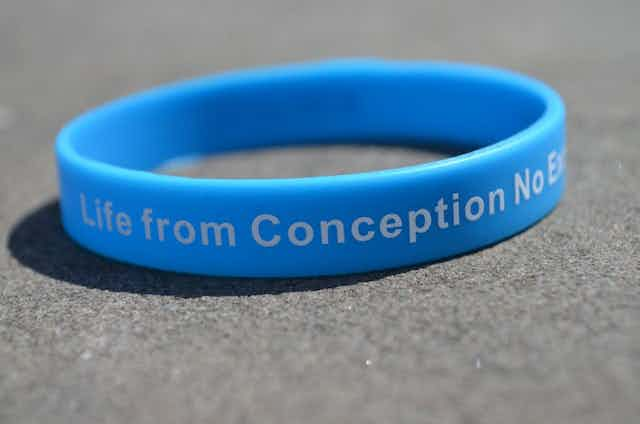Birmingham hosted the fourth annual March for Life, bringing together “pro-life” campaigners from across the UK (and further afield, including Ireland, France, Spain, Mexico, Slovakia).
The event was much bigger than last year. We counted around 1,000 participants in all, double the number attending in 2015. And this was a much slicker operation than what has been seen before.
Crash barriers and professional security cordoned off space in Victoria Square. Entrance was controlled by the organisers and the speakers and musicians had a professional PA, stage, and big screen. There were even merchandise stalls and face-painting.
The event marketing seemed designed to appeal especially to a youth demographic. We saw the slogan “Life from Conception, No Exception!” printed on wristbands, hoodies and t-shirts. One participant told us: “It’s got a kind of a Glastonbury feel about it!”.
Last year, it took just a line of police to separate marchers from abortion rights campaigners, who were able to disrupt the closing rally, drowning out the PA system.
Changing approach
On this evidence, the anti-abortion movement, if still very small, is growing in mainland Britain.
But that growth could cause dilemmas. The marchers seemed united against abortion but less in agreement about what should actually be done about it.
Some argued: “We’re not here to change the law, we’re here to save lives,” while others spoke of closing down “the abortion industry”.

For some, pro-life activism is a personal commitment to make a difference as an individual, offering what they see as support to other women, through and after pregnancy. Others told us that getting an abortion in Britain is currently “too easy”. The wish to provide support is very different from making it harder for women to get an abortion by changing the law.
Every participant we spoke to defined abortion as the murder of human life (several told us their belief that life begins at conception was supported by science). But again, they struggled to reach a definitive conclusion on how this should be handled.
One student activist suggested abortion should be considered infanticide before backtracking and agreeing that women should not be prosecuted for having an abortion. This may be only a personal view but it points to an absent common position on how women who have abortions should be treated.
How to represent abortion at events of this kind is another crucial issue. Last year, organisers stressed that participants should not display graphic images of aborted foetuses. This year, the official position was left unspoken, publicly, at least.
The question is important if the march is to bring together activists from often diverse groups. Abort67 – which has courted controversy for its use of graphic images – ran a stall at this year’s event; but, unusually, did not openly display its signs. The march’s official signs carried slogans, whilst banners showed images of babies. The event avoided the issue by not representing abortion in images at all.
Familiar Catholic iconography was on display, including a Cross of Life, where participants could place prayers, and a Mercy Bus – a sort of mobile confession box.
But we saw more secular elements being woven into proceedings this year. Ryan Bomberger, of the pro-life Radiance Foundation, claimed abortion is “the social injustice of the day” because it implies that “somehow, some lives are more equal than others”.
Bomberger even co-opted celebrity, encouraging demonstrators to wave their iPhones in the air. The logic here seemed to be that Apple founder Steve Jobs, like Bomberger, had been adopted – proving that great opportunities can be missed because of abortion.
Following the march, Canadian pro-life activist Stephanie Gray, gave a contrasting talk. Where Bomberger was upbeat and motivational, Gray was careworn and emotional as she described a “broken culture”.
She said we must “learn how to weep for the 200,000 little children who die every year in the UK”. Asking the crowd to treat activism as a daily event, Gray steeped her talk in messages of good and evil, and the need to pray for abortionists’ souls, as they have “followed the father of lies and the prince of darkness”.
The event culminated with a vigil led by one of three Bishops, who offered prayers to all constituents in the abortion debate, from pregnant mothers to medical practitioners, and a minute’s silence “to pray for the victims of abortion”.
A changing response
The changing nature of this march over the years, particular in terms of scale, reveals subtle shifts in its ambitions and its target audience. By bringing in secular elements and branding, it is clearly trying to appeal beyond its core supporters, into the wider public.

But from our observations, it looks like the anti-abortion movement remains some way from its goal of appealing beyond a limited strain of committed Catholicism.
There is also still a reliance on speakers from North America and Africa, where the anti-abortion movement is more developed. This is perhaps a reminder that it has had a harder time gaining traction in Britain’s broadly liberal secular landscape.
That said, it’s clear that the event’s increased professionalism also poses questions for abortion rights activists in the UK. Faced with an evolving British pro-life movement, they will have to think carefully about how to react, and how to defend access to abortion in Britain.

